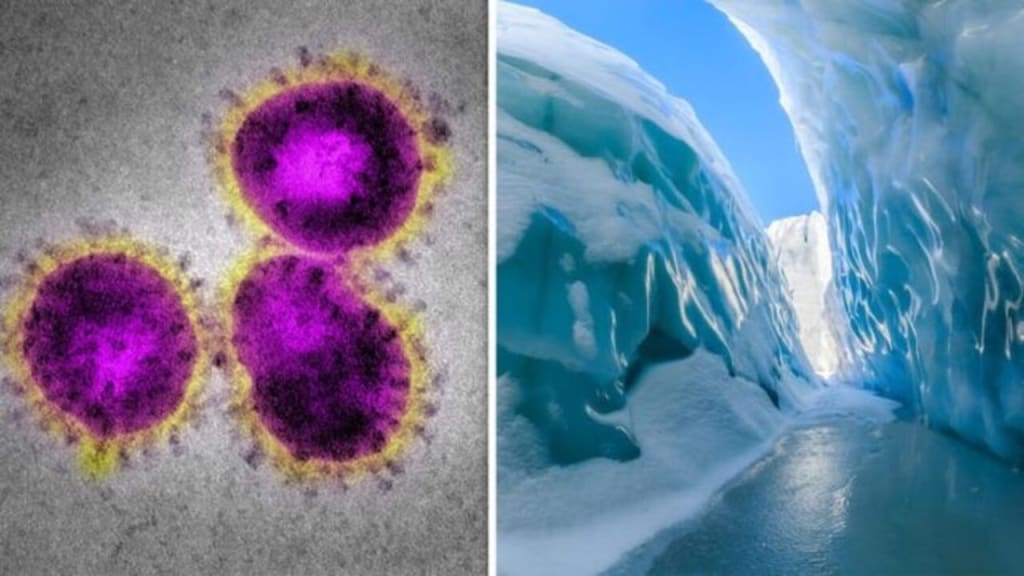Is It Time To Panic Yet?
And Will It Ever Happen To Us?

A one of a kind find was discovered in the permafrost of Siberia. Meet Sparta, a lion cub. It's the best preserved frozen specimen from the last ice age ever found. Lions usually sleep 20 hours a day, but this lion cub took a 28,000-year nap.
Despite this, it has well-preserved fur, internal organs, a skeleton, and even whiskers. But most importantly, the cub may still hold some of its mother's milk inside it. Thanks to it, scientists will be able to determine what the lion cub's mother used to feed on. For many years, the information concerning what lions could eat under the harsh Siberian conditions remained a mystery. But there's a downside to such finds.
Exploring the ice mountains of Siberia, scientists can encounter not only perfectly preserved creatures but also perfectly preserved viruses. And the worst part of it is that, unlike a lion cub, viruses can recover on their own. In this story, you'll find out, if will we be able to see a living mammoth. What kind of menace has the Siberian freezer kept for us for years? And should we oppose the research missions to Siberia?
As you can see, the icy climate of Siberia is a veritable jackpot for researchers. For example, there they found this ancient rhinoceros that lived about 50,000 years ago. It's covered in wool and looks more like a stuffed animal. It probably lived apart from its mother after being lost and most likely died by drowning in the summer. It's a pity it won't find its mother to live a long and happy life.
Unlike the Yucca mammoth, which has a chance to be cloned, Yucca remained frozen for 39,000 years. Scientists were stunned when they found perfectly preserved muscle tissue and even blood because no one was ever able to extract flowing blood from a mammoth. Its story is pretty much the same as the woolly rhinos. Probably the mammoth fell into water or got bogged down in a swamp, couldn't free itself, and died.
It looks like another found cub of ancient animals suggests that moms didn't bother performing better at their duties back then.
But let's look at the bright side. Scientists can revive this species using Yuka's DNA. The fact that the creatures found in Siberia can be brought back to life is also demonstrated by a Deloid rotifer. You say it's not as cute as the fluffy rhino in the mammoth. Well, the scientists got excited about the rotifer.
Previous studies showed that they can live in a frozen state for up to 10 years, but a new study suggests that they could last for thousands of years, if not indefinitely. This particular specimen is 24,000 years old. The Deloid rotifer returned to life immediately after being thawed, without any involvement of scientists.
And it's pretty staggering. It wasted no time. And the first thing on its to-do list was to start reproducing. The thing is that these microscopic multicellular organisms can do it asexually. Observing such discoveries in the Siberian permafrost is quite interesting.
However, some specimens are probably better left frozen. The most shocking discoveries were made in the Denisova cave in southern Siberia. At different times, it was home to ancient people of 20 cultural eras. Researchers found a new bone fragment there, but they couldn't tell who it belonged to. It was either a Denisovan, a subspecies of human who was the first to inhabit the cave or a Neanderthal who lived there later.
The bone was then submitted to Leipzig for genetic analysis. It turned out it belonged to a young female aged at least 13 years old. And she was a hybrid. It's the first-ever individual whose parents belonged to distinct human groups. The fact that Denisovans and Neanderthals could live in the cave at the same time and even interact is a real historical sensation.
But the researchers were even more surprised by the unusual burial of another child about 10 years old. The point is that the child was buried in a somewhat atypical way, namely in a sitting position. Such a position in the grave is very unusual for Bronze Age burials.
In an attempt to solve this historical puzzle, scientists attributed various things to a mysterious grave, such as ancient people's understanding of the surrounding space, their sacred vision of the cardinal directions, and their belief in the afterlife. But they never found the right answer. No! No! Bad squirrel! Those are my nuts! My nuts! And here's another question.
Is it ethical, even for scientific purposes, to invade a human burial site? Moreover, we don't know what will happen if scientists thaw out the grave of a person who was, for example, seriously ill. Then outbreaks of ancient deadly diseases can occur again.
In 2014, French evolutionary biologists, the husband and wife team Jean-Michel Clavary and Chantal Abergill, noticed amoebas dying in a thawed ice sample. The cause of their death was a virus that was 30,000 years old. It disappeared a long time ago, but it survived in the permafrost. It was called Pythovirus Cybricum. It became the biggest virus known today.
1.5 micrometers in length and 0.5 micrometers in diameter. The following year, in the same sample of permafrost, scientists discovered another giant virus, Mola virus Sibericum, the amoeba infected with it.
becomes kind of a factory for its production, which ensures the spread of the infection. Although these ancient giant viruses infect only microorganisms, their ability to spring to life after millennia is alarming. Scientists don't exclude that there are viruses in permafrost that are dangerous to humans.
Does it mean that research missions in Siberia are dangerous to humanity? When the news is saying, In Siberia, scientists discovered an ancient deadly virus in the ice, we feel like screaming, No! Please! No, that's just it!
Nowadays, our planet is still fighting a pandemic, and I don't think we'll be able to cope with any new, unknown infections. But in fact, their emergence doesn't depend on the researchers in Siberia at all. It's all about climate change affecting the Arctic. This area becomes warmer at least twice as fast as the rest of the planet, so the ancient viruses defrost on their own. The same kind of thing happened in 2016.
An anthrax outbreak started in Yamalonennets Autonomous Okrug. Back then, about 2,000 deer died, 72 people were hospitalized, and one child passed away. As it turned out, during an abnormally hot summer, the permafrost thawed deeper than usual and the deer ate bacteria-contaminated dirt together with plants. Researchers noted that in recent years in the Russian Arctic, there's been a surge in diseases such as tick-
Borne encephalitis, brucellosis, tularemia, leptospirosis, rabies, and anthrax among domestic and wild animals. Scientists need to identify the source of these viral and bacterial infections as soon as possible because many of them are zoonotic. That is, they occur in animal populations, but then they can be transmitted to humans. Such finds in Siberia can scare us.
But scientists' recovery in research of viruses is a necessary measure to save our lives. It's challenging to surprise the researchers of permafrost. But since everything is so perfectly preserved in the ice of Siberia, what if we leave there some object that would make scientists from the future pull their hair out? For example, a collectible anime figure. It'll make our descendants think that Naruto was our deity.
or an egg cutter, which will be mistaken for a torture device. Remember, if you go skiing in Siberia and you see an avalanche, I recommend freezing in the most confusing position. Like this or this. Let the future archaeologists go crazy trying to figure out why you froze like that.
About the Creator
Corey Turner
Reading really is fundamental






Comments
There are no comments for this story
Be the first to respond and start the conversation.